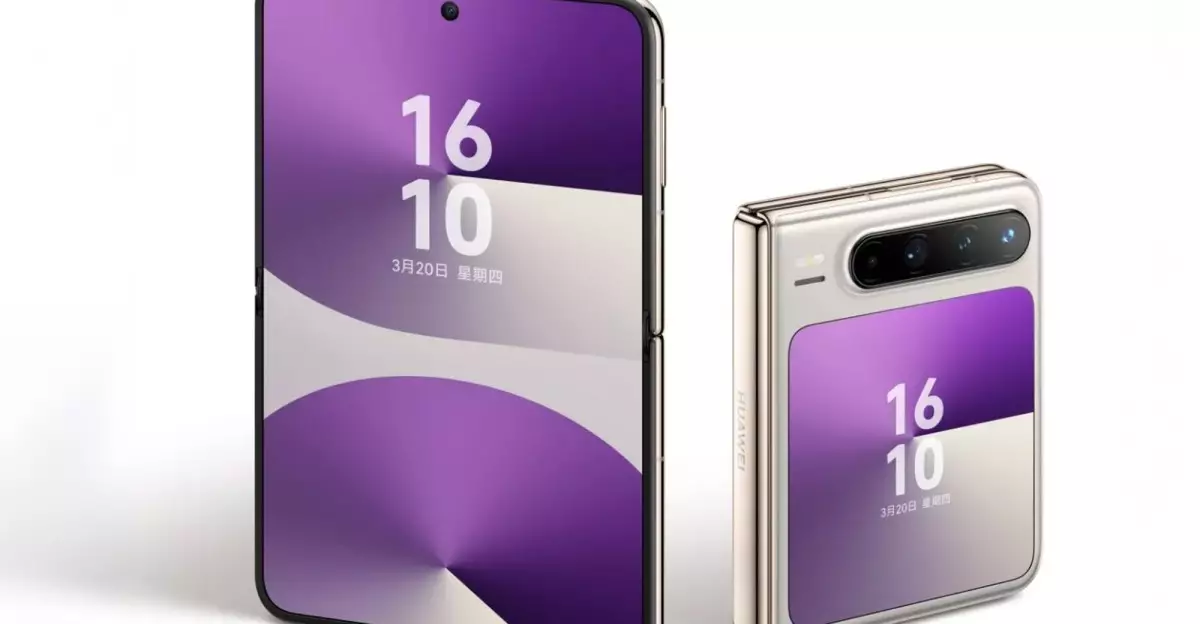The Huawei Pura X marks a significant leap in smartphone innovation, representing a brave new approach in design and functionality. Unlike traditional smartphones that have followed the vertical flip trend, the Pura X introduces a sideways hinge mechanism. This radical shift creates a wider device that not only challenges established norms but also redefines user experience. The phone’s form factor leans toward a tablet-esque aspect ratio, making it a captivating addition to the marketplace that savvy consumers should consider.
In a world dominated by conventional mobile devices, the Pura X stands out with its unique aesthetics reminiscent of flagship models like the Samsung Galaxy Flip and Motorola Razr. When closed, it presents a sleek profile with a square cover screen that cleverly accommodates a triple camera setup. This intelligent design decision showcases Huawei’s commitment to blending functionality with style, allowing for a more versatile use-case scenario.
Pioneering Operating Systems: A Bold Move Away from Android
One of the most groundbreaking features of the Pura X is its shift away from Android operating system compatibility. Instead, it runs exclusively on HarmonyOS Next. While the transition from a globally recognized platform to an in-house OS may raise eyebrows, it signals Huawei’s ambition to establish itself as an independent force in the tech arena. Unlike its predecessor, which sometimes relied on Android foundation structures, HarmonyOS Next strives to deliver a uniquely integrated experience that reflects Huawei’s vision of technology.
This phone is a harbinger of an era where competition among operating systems may heat up, as it doesn’t cater to the broad spectrum of Android apps. Instead, the Pura X engenders a new environment where developers must embrace this novel platform or watch it flourish without them. Observers should watch closely as HarmonyOS Next carves out its identity and its ability to attract a dedicated user base.
Introducing Harmony Intelligence: The AI of the Future
A standout element of the Huawei Pura X is Harmony Intelligence, the company’s inaugural Artificial Intelligence assistant built upon the advanced Pangu model, enhanced by DeepSeek technology. In an age where AI becomes an integral part of user experience, Huawei has positioned itself at the forefront of the AI revolution. Nvidia’s CEO, Jensen Huang, has openly acknowledged Huawei’s burgeoning prowess in artificial intelligence, reinforcing a sentiment that industry observers cannot afford to overlook.
Harmony Intelligence promises to redefine user interaction by leveraging cutting-edge machine learning to better understand and anticipate user needs. With voice commands and intelligent suggestions, Huawei is attempting to put powerful AI in the hands of everyday users. This is not just another AI tool; it is a sophisticated assistant capable of evolving alongside its owner. As AI continues to become deeply interwoven into the fabric of our daily lives, Huawei’s commitment to developing in-house capabilities could set a precedent that competitors might struggle to follow.
Market Implications and Future of Smart Technology
The Huawei Pura X is presently available only in China, starting at a price around 7,499 yuan (approximately $1,037). This pricing strategy reflects a premium offering that has the potential to resonate with tech enthusiasts and trendsetters in a competitive smartphone market. The phone’s unique features may seem tailored for a niche audience, but it could also pave the way for broader acceptance by enticing more mainstream consumers over time.
As the technology landscape evolves, Huawei’s decision to craft the Pura X without reliance on established norms showcases its courageous vision. However, it raises questions: Will consumers embrace this change, or will hesitation with new formats and operating systems stifle it? Only time will tell if the Pura X’s innovative spirit ignites a revolution in smartphone design and technology.
Amidst all the excitement surrounding the Pura X, there remains anticipation for what’s next from other brands, especially with the prospect of rollable phones taking center stage in the not-so-distant future. However, for now, Huawei commands the spotlight, pushing the boundaries and provoking thought on how smartphones will evolve in the coming years.

